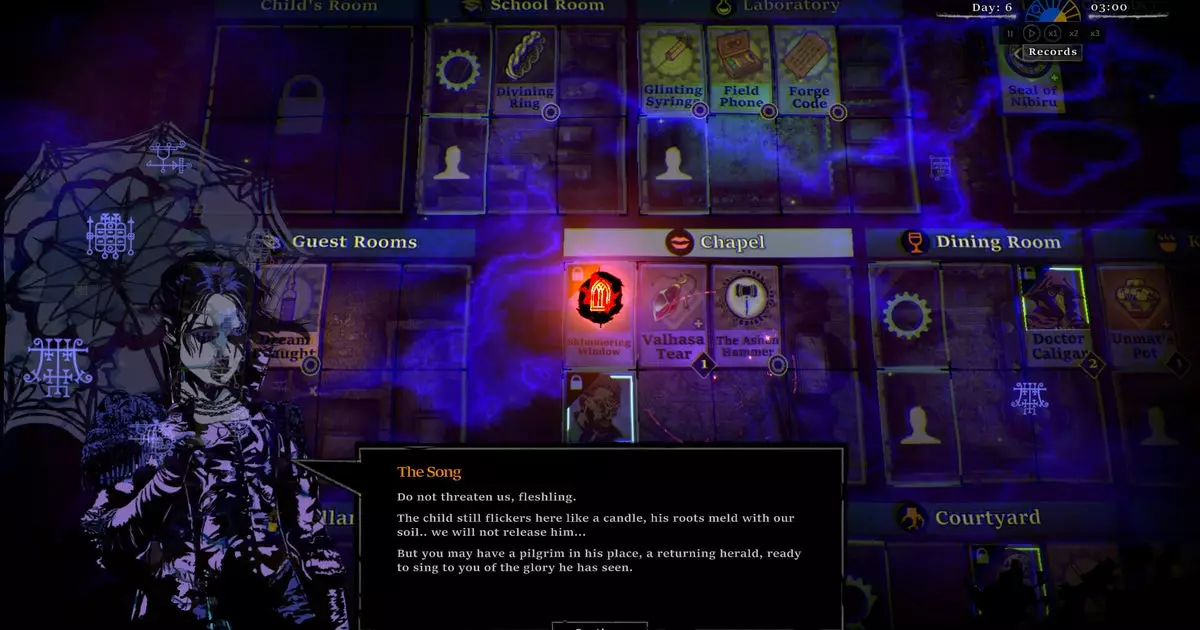The immersive experience of The Horror At Highrook transports players into a dynamically shifting game world, where the ambiance serves as a visual narrative of its own. Drawing parallels to renowned titles like Darkest Dungeon, this haunted house RPG crafts a rich tapestry of colors that transition from the drabness of day to the ethereal elegance of moonlit nights. Such artistry not only enchants the eye but also creates an emotional resonance, revealing the underlying tension between beauty and foreboding that permeates the game.
The game’s setting, an abandoned mansion rife with mystery, beckons players to delve deeper. However, just as one becomes entranced by its aesthetic charm, gameplay mechanics urge them to remain vigilant. A stagnating party leads to hunger, fatigue, and eventually madness, forcing players into constant engagement. This relentless pacing interweaves with the visual splendor, prompting a delightful tension where the pressure of survival coexists with the haunting allure of discovery.
Central to the experience of The Horror At Highrook is a series of resource management mechanics that spring into life as players juggle various challenges within the haunted estate. The player’s characters must be strategically positioned within the environment to optimize their skills and resources. For example, one character might explore the kitchen to prepare vital sustenance, while another hunts through archives for secrets that unlock further mysteries.
As players manage their party’s basic requirements, they inch closer to the core narrative—unraveling the enigmatic fate of the Ackeron family. The game is structured around a series of tasks that serve dual purposes: satisfying immediate needs and piecing together the deeper lore encased within the mansion’s walls. These range from mundane (retrieving supplies) to the elaborate (deciphering forgotten texts), integrating player effort with the unfolding story and enhancing engagement.
The unique card-based system adds an additional layer to both the gameplay and narrative structure. Every card represents not only a task or a resource but also embodies the vulnerabilities and strengths of the characters involved, allowing for a dynamic interplay between stats and strategic choices. This mechanic invites comparisons to cult classics like Cultist Simulator due to its multifaceted representation of character skills and resources.
Characters like Caligula, the plague doctor, are equipped with cards that grant them special abilities, creating a multifarious landscape of interaction between the player’s decisions and character development. Cards like “The Gift of the Bee” connect deeply to the themes of discovery and transformation, linking character arc with gameplay objectives. While this mechanic can offer depth, it also runs the risk of overwhelming players, particularly with verbose card descriptions that may detract from a more immediate, instinctive gameplay experience.
While The Horror At Highrook is visually enchanting, its ambitious approach to storytelling does create moments of complexity that challenge player comprehension. The rich prose weaves an atmospheric thread, but at times it may feel cumbersome—a slight hindrance when players navigate through multiple objectives requiring swift tactical responses. The pause button serves as a necessary tool, allowing players to absorb the wealth of information presented. However, reliance on this mechanic can disrupt the pacing and flow that such a game strives to maintain.
Furthermore, character development needs careful crafting, particularly with accents and backgrounds that feel inconsistent or ambiguous. Atticus Hawk, for instance, left players wondering about his origins—whether he encapsulates a British heritage or an American vibe. Such inconsistencies can detract from immersion and character relatability, requiring slightly more nuanced storytelling.
The Horror At Highrook offers players a mesmerizing journey through a haunted mansion fraught with secrets and discoveries. With its unique blend of resource management, card-based mechanics, and a richly crafted aesthetic, it successfully captivates the player’s imagination. However, the complexity of its character narratives and game mechanics represents a double-edged sword; while they enhance engagement, they also risk alienating players who prefer more straightforward interaction.
As players navigate the delicate intricacies of The Horror At Highrook, they are not only pulled into its engaging gameplay but also into a wider discourse on how games tell stories while simultaneously demanding tactical engagement. Only time will tell if future developments of this title will refine its mechanics or further immerse us in its haunted world of wonder.


Leave a Reply